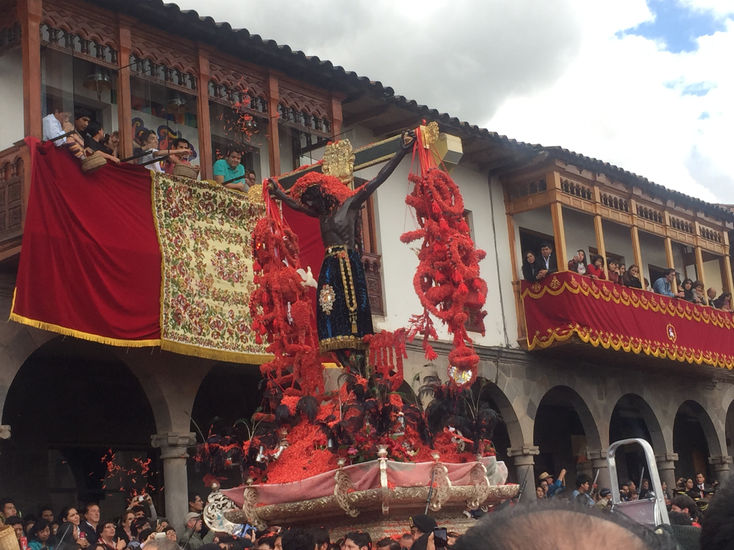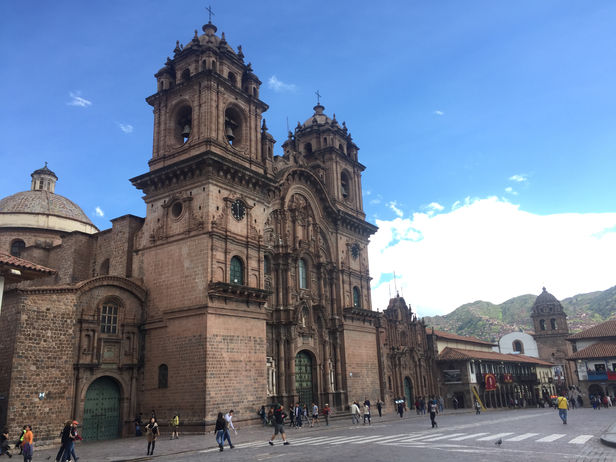THE COLOR OF THE ANDES
We arrived in Cuzco five or seven days before Karen and Charlotte arrived (Aaron's mom and aunt, respectively). During that time we did not do any sight seeing, other than local food markets and restaurants. We had found a nice hostel (Okidoki) that was right at our desired price, which was not easy to find at first. Okidoki had great personnel excited to hear our stories and even more stoked to share theirs. An exchange with one of the guys that worked there, Manuel, lasted greater than an hour and he shared with us his spirituality (a belief system that combines traditional and catholic beliefs) and his frustration with the tourist industry (on one hand it provides economic means while on the other tourism destroys the very core of the economic motor). It was a beautiful sharing experience. Erin had been focusing so intently she got light headed and almost lost it - cold sweats, tunnel vision, over heated - luckily it all passed as soon as she sat down.
Once Karen and Charlotte arrived we dove deep into the touristic realm. We visited some impressive ruins in the city of Cusco, at its out-skirts, and the Sacred Valley all the way to Machu Pichu.. Charlotte, Aaron's aunt, had worked as a travel agent for 30+ years and had some amazing friends in the Cusco area. Our experience with the guides in Cusco were for the most part positive. However, there was one who really did a poor job. She provided false information, such as: "Quechua and Spanish are the two languages in Peru". When I challenged her "What about Aymara", she said "that is only spoken in Bolivia. Here we speak Quechua, in Bolivia they speak Aymara". At that response I gave up…didn't even try to go there with her. Totally false. Quechua, Aymara, and Spanish are all spoken in both Peru and Bolivia…not to mention the indigenous languages from the lowlands and jungles. I was really disappointed to hear such stubborn ignorance from someone who makes money off the information (false) shared unto others. Although her misinformation made us question the rest of what she shared, the ruins of Qorikancha Saqsaywaman, Tambomachay, Qorikancha, Puka Pukara, and Q'enqo required nothing to stand out independently as impressive remnants of an ancient rich culture.

Once Karen and Charlotte arrived we dove deep into the touristic realm. We visited some impressive ruins in the city of Cusco, at its out-skirts, and the Sacred Valley all the way to Machu Pichu.. Charlotte, Aaron's aunt, had worked as a travel agent for 30+ years and had some amazing friends in the Cusco area. Our experience with the guides in Cusco were for the most part positive. However, there was one who really did a poor job. She provided false information, such as: "Quechua and Spanish are the two languages in Peru". When I challenged her "What about Aymara", she said "that is only spoken in Bolivia. Here we speak Quechua, in Bolivia they speak Aymara". At that response I gave up…didn't even try to go there with her. Totally false. Quechua, Aymara, and Spanish are all spoken in both Peru and Bolivia…not to mention the indigenous languages from the lowlands and jungles. I was really disappointed to hear such stubborn ignorance from someone who makes money off the information (false) shared unto others. Although her misinformation made us question the rest of what she shared, the ruins of Qorikancha Saqsaywaman, Tambomachay, Qorikancha, Puka Pukara, and Q'enqo required nothing to stand out independently as impressive remnants of an ancient rich culture.
Saqsaywaman is an ancient Incan ruin, built with huge limestones brought from 2 km away on stone rollers and human power. Built in the later 1400s, in a 50 year time span, using 50,000 men, Saqsaywaman is believed to have been a fortress and house of the sun god. The large stone structure functioned both as a military and religious center until the spanish conquest of the Inca. When the spanish arrived they destroyed an estimated 60% of the fortress and stole the stones and built cathedrals in the center of Cusco. We then went to Tambomachay, a water temple conveying Inca principles of duality and displaying their mastery of hydraulics. We also visited Puka Pukara, Inca military ruins, and Q'enqo, where ceremonies such as sacrifices and mummifications took place.
After visiting the ruins of Cusco and its surrounding areas, we went into the Sacred Valley to explore more Incan remains. The places that stood out the most were Pisac, Ollantantambo, and Moray. Pisac has an amazing silver market, that could have consumed all my savings had I not practiced self constraint. Ollantaytambo had some of the most impressive ruins, as impressive as Machu Pichu in my opinion, that share architectural techniques and ceremonial symbols with the Bolivian Tihuanaco culture. Moray we found fascinating. The depressions that characterize the Moray ruins case a change in temperature of 15 C (27 F); speculation about the cite has led many to believe the ruins were once used as an agricultural testing ground.
Lastly but not least we visited Machu Pichu. Privileged to be there again, I (Erin) relived wonderful memories of when I had visited with my grandma, mom, and brother back in the 90s. However, the mountains were as impressive as always and its valleys held some special energy if you took the time to feel it. We found a quiet spot, away from the other visitors, made some offerings for our loved ones and sat and imagined what the energy and dynamics of the place would be like back during its climax. So fascinating to try and imagine what our past human societies were like.
























